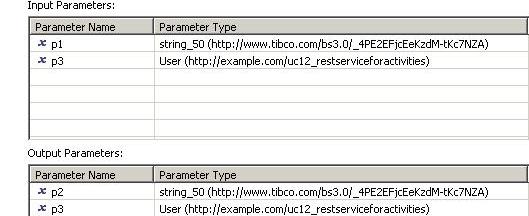This exposes the REST interface for the business process, and the service and module name fields are populated with the values required for invoking the REST service at runtime.

You also see the following information on any input and output parameters that are defined for that activity:

The following table describes the input parameters:
| Parameter Name
|
Name of parameter to use:
- For a user defined WSDL this is the original message partname prefixed with “In” (to avoid confusion between same named input/output parts that are of different types).
- For an auto-generated WSDL, the name matches the business process parameter name.
|
| Parameter Type:
|
The XSD type of the element and its namespace in the format:
TypeName (namespace)
|
The following table describes the output parameters. Note that the output parameters are only shown for request-reply services when there are output parameters associated with the activity or the activity has 'Reply Immediately With Process Id' option selected.
| Parameter Name
|
Name of parameter to use:
- For a user defined WSDL this is the original message partname prefixed with “Out” (to avoid confusion between same named input/output parts that are of different types).
- For an auto-generated WSDL, the name matches the business process parameter name..
|
| Parameter Type:
|
The XSD type of the element and its namespace in the format:
TypeName (namespace)
|


